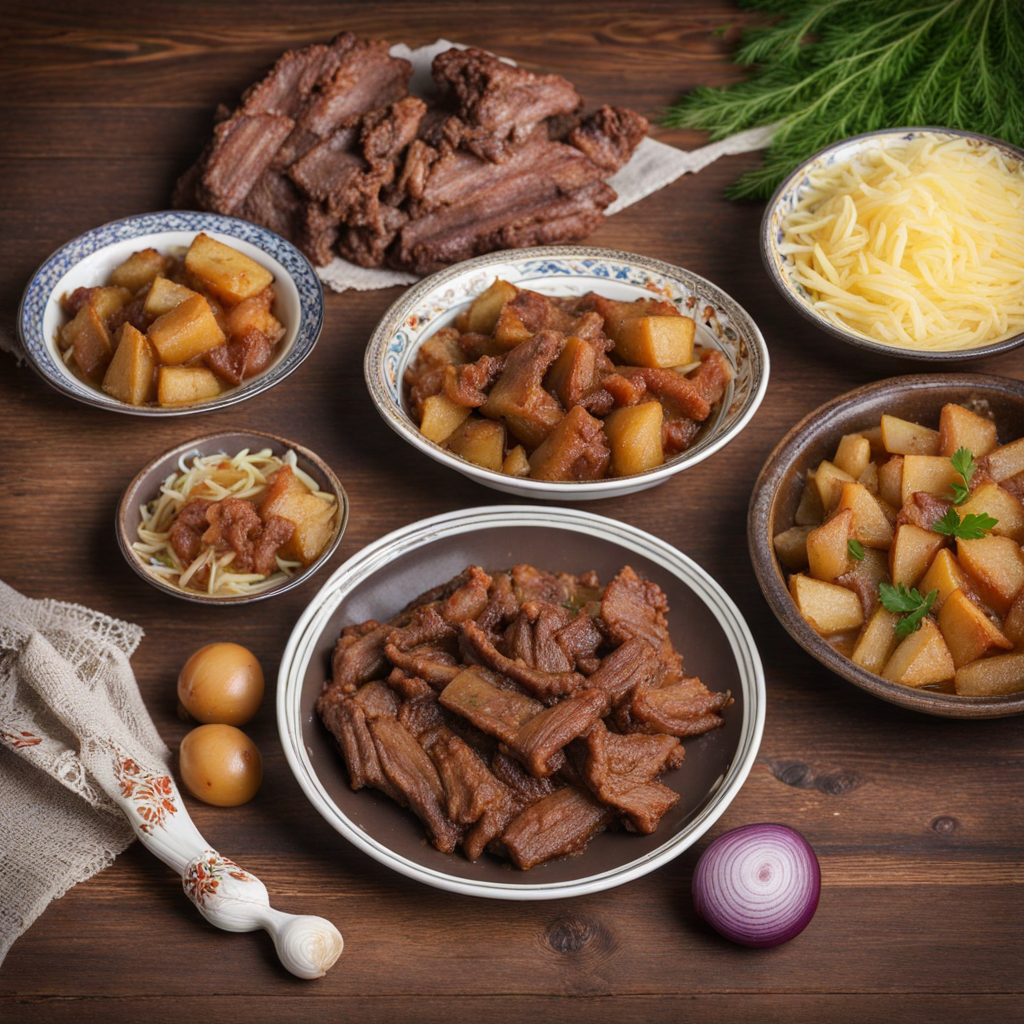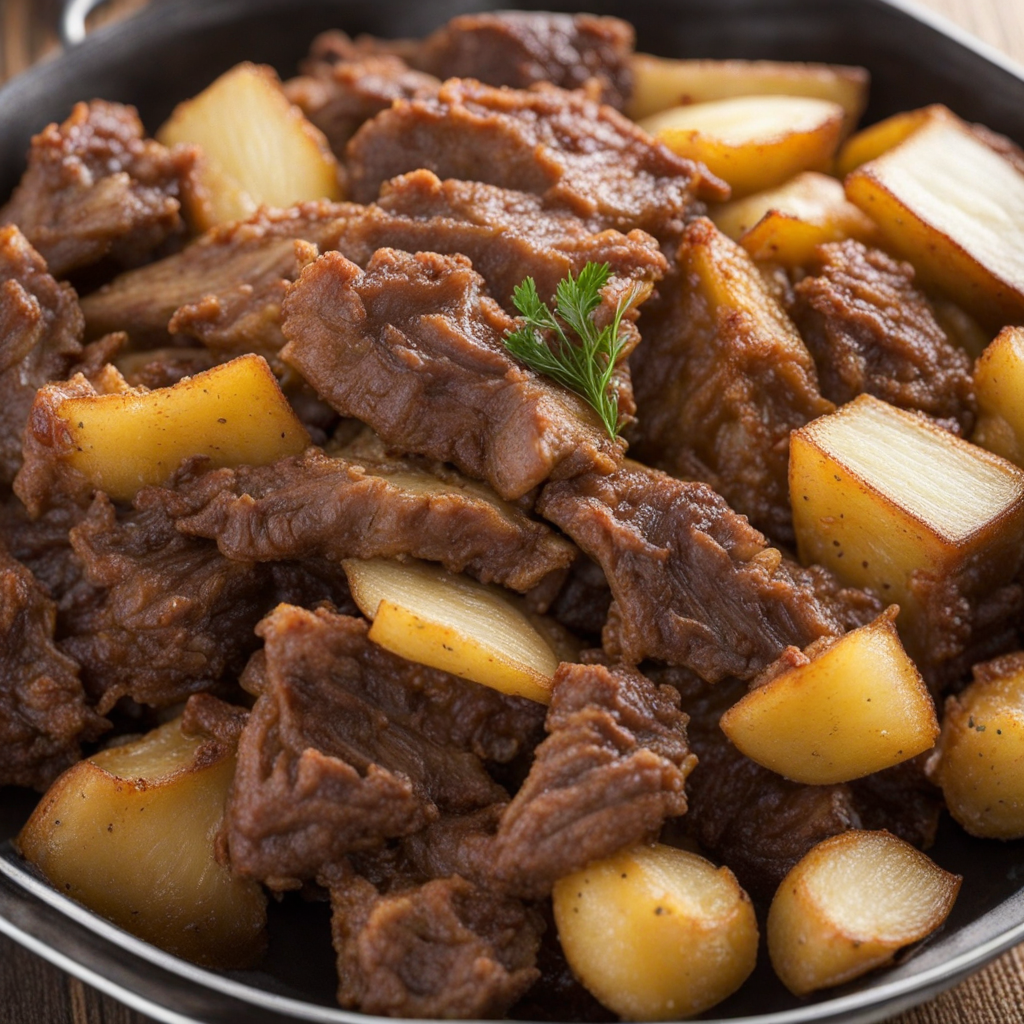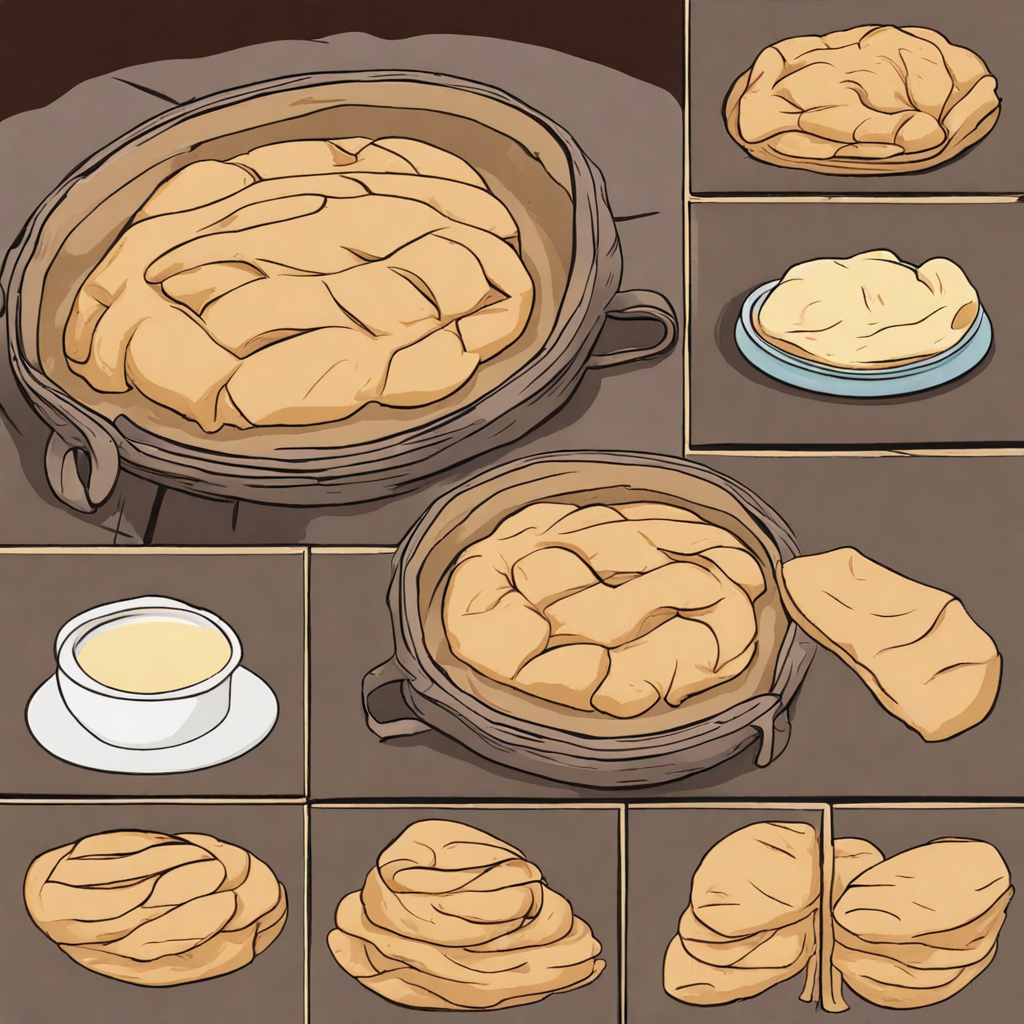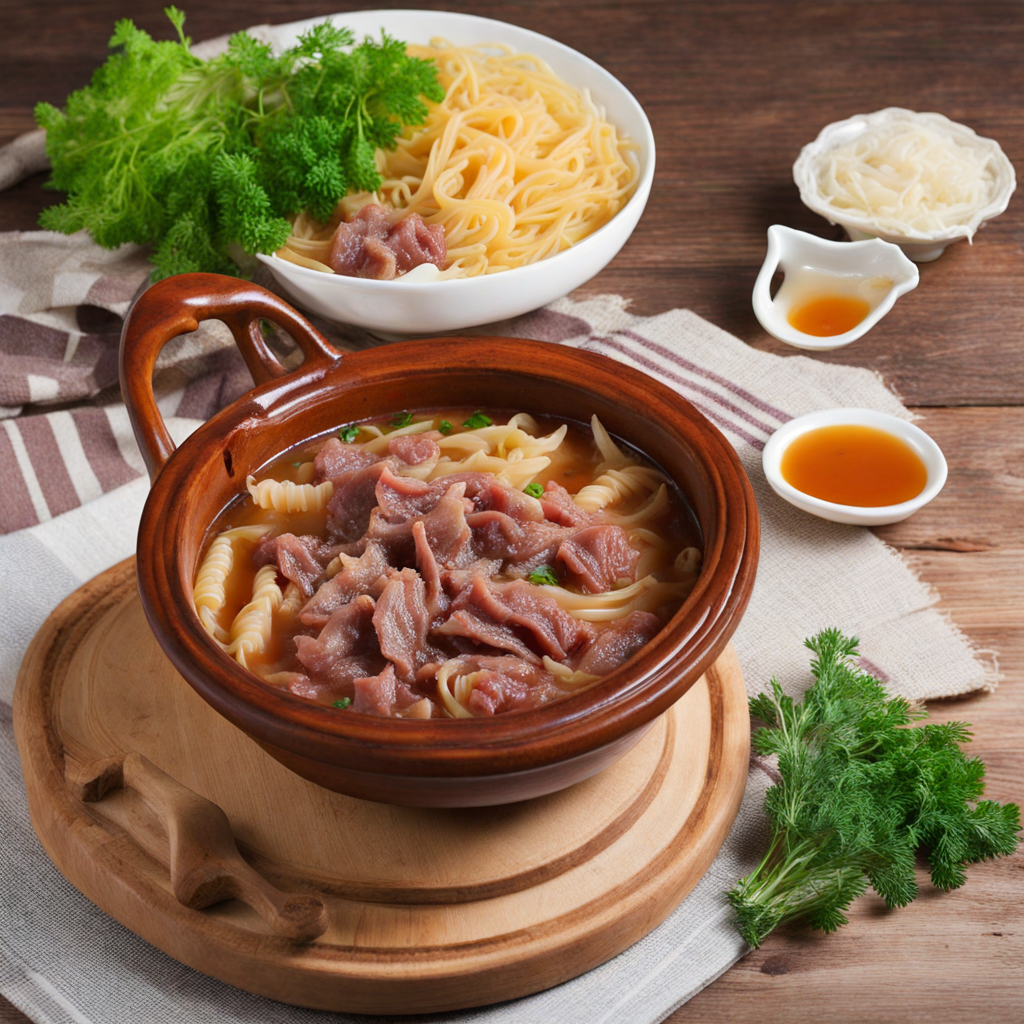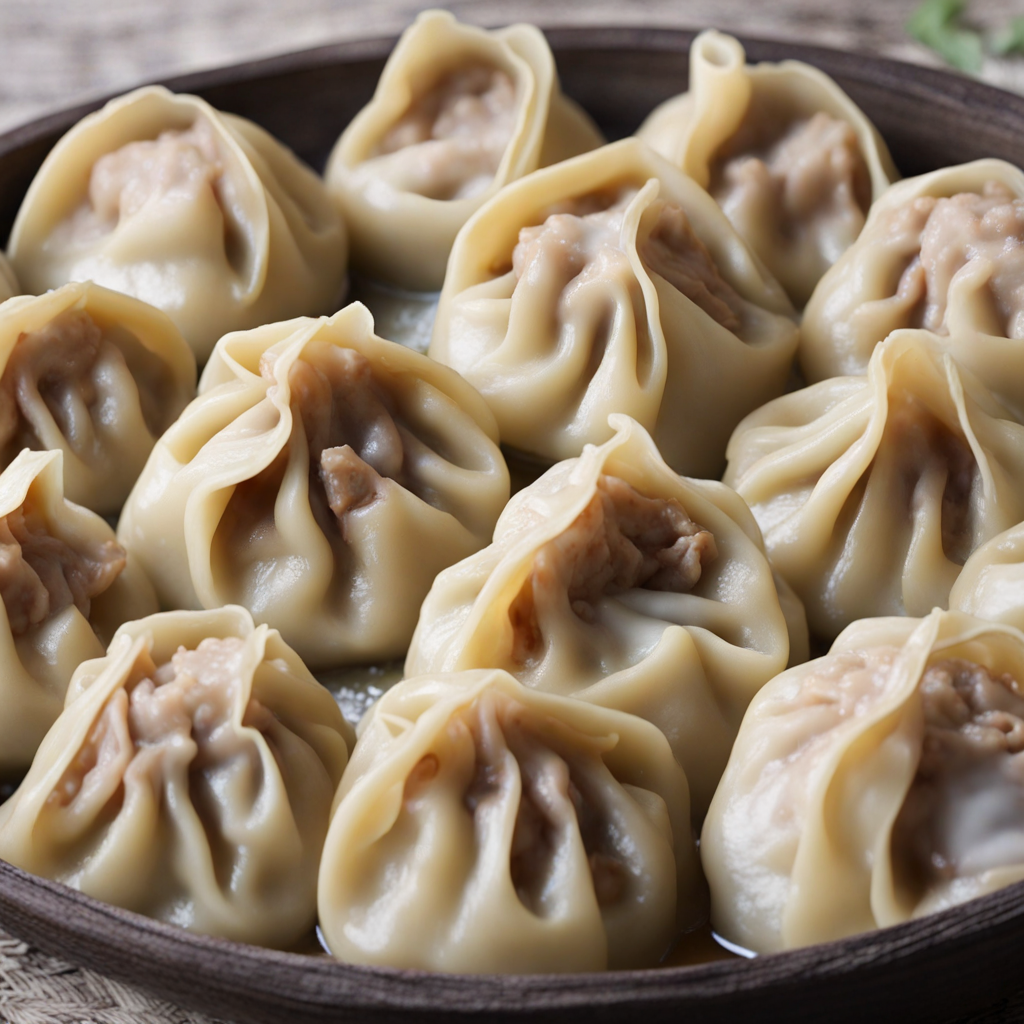Kuurdak
Kuurdak is a traditional Kazakh dish that embodies the rich flavors and hearty essence of the Central Asian culinary heritage. At its core, Kuurdak is a savory meat dish, typically made with lamb or beef, which is cooked with onions and seasoned with a blend of spices that may include black pepper, cumin, and salt. The meat is slow-cooked until it becomes tender and infused with the aromatic flavors of the onions, creating a dish that is both satisfying and deeply flavorful. The method of preparation often involves frying the meat and onions together in a cast-iron pan, allowing the ingredients to caramelize and develop a rich, golden-brown crust that adds depth to the overall taste. The dish is often served with potatoes or bread, which soak up the delicious juices and complement the robust flavors of the meat. In some variations, Kuurdak may also include additional vegetables, such as carrots or bell peppers, adding a touch of sweetness and color to the dish. The combination of tender meat, caramelized onions, and spices creates a balance of savory and slightly smoky notes that are characteristic of Kazakh cuisine. Each bite offers a comforting experience, reminiscent of family gatherings and communal meals that celebrate the warmth of Kazakh hospitality. Kuurdak is not just a meal; it’s a culinary experience that tells the story of the nomadic lifestyle of the Kazakh people. Traditionally, it is prepared over an open fire or in a large cauldron, making it a popular choice for gatherings and celebrations. The rustic nature of the dish, along with its hearty ingredients, makes it a symbol of sustenance and community. For those looking to explore new tastes, Kuurdak offers a unique opportunity to savor the authentic flavors of Kazakhstan, inviting you to indulge in a dish that is both simple and profoundly satisfying.
How It Became This Dish
Origin of Қуырдақ Қуырдақ is a traditional dish from Kazakhstan that holds a significant place in the country's culinary heritage. The name itself derives from the Kazakh word “қуыру,” which means “frying.” This reflects the fundamental cooking method used to prepare the dish. Its origins can be traced back to the nomadic lifestyle of the Kazakh people, who relied on the resources available to them in the vast steppes. As a meat-centric cuisine, Қуырдақ is primarily made from lamb or beef, often combined with various organs such as liver, heart, and kidneys, showcasing the resourcefulness of the nomadic tribes that sought to utilize every part of the animal. Historically, Kazakh nomads would prepare Қуырдақ during significant gatherings, celebrations, or feasts, demonstrating their hospitality and culinary expertise. The dish served not just as a meal but as a symbol of communal effort and sharing, which is integral to Kazakh culture. It embodies the spirit of togetherness, as it is typically cooked in large quantities to serve family and friends, reinforcing social bonds. \n\n Cultural Significance Қуырдақ is more than just a dish; it is a cultural emblem that encapsulates the traditions and values of the Kazakh people. In the context of hospitality, preparing and serving this dish is a gesture of respect and honor to guests. In the past, it was customary to present the best pieces of meat to the most esteemed visitors, reflecting the high regard in which guests were held in Kazakh society. The preparation of Қуырдақ also ties closely with the concept of "dastarkhan," which refers to the traditional table setting laden with food. This concept emphasizes the importance of sharing meals as a social activity, where stories and experiences are exchanged. During special occasions such as weddings or holiday celebrations, the presence of Қуырдақ on the dastarkhan signifies abundance and joy, reinforcing its status as a dish of importance. \n\n Ingredients and Preparation The ingredients of Қуырдақ reflect the natural resources available in the Kazakh steppes. Traditionally, the dish is prepared using lamb or beef, with the choice often depending on regional preferences and availability. The inclusion of offal, such as liver and kidneys, underscores the nomadic tradition of utilizing every part of the animal. To prepare Қуырдақ, the meat is typically cut into small cubes and fried in a large cast-iron pot or cauldron known as a "kazan." Onions and potatoes are often added to enhance the flavor and texture of the dish. Spices such as salt, black pepper, and sometimes cumin are used, although the focus remains on the natural flavors of the meat and vegetables. The cooking process is essential, as it involves frying the ingredients until they are golden brown, allowing the flavors to meld together, creating a rich and savory dish. \n\n Regional Variations As Kazakhstan is a vast country with diverse geographical and cultural influences, variations of Қуырдақ have emerged over time. In different regions, you may find variations in the choice of meat, the inclusion of additional vegetables, and even the spices used. For instance, in the north, where beef is more commonly consumed, you may find a heartier version of the dish, while in the south, lamb might take precedence. In addition to regional differences, modern interpretations of Қуырдақ have also begun to surface, influenced by global culinary trends. Some chefs experiment with alternative meats, such as poultry or even game, and incorporate contemporary cooking techniques. However, the traditional preparation remains a cherished aspect of Kazakh cuisine, with many families passing down their unique recipes through generations, ensuring the legacy of this dish continues. \n\n Modern Day Significance In contemporary Kazakhstan, Қуырдақ continues to be celebrated as a beloved dish, often featured at family gatherings, holidays, and national celebrations. Its status as a traditional food has been reinforced by a growing interest in preserving and promoting Kazakh culture amidst globalization. Restaurants and cafes across the country proudly serve this dish, allowing both locals and tourists to experience its rich flavors and cultural significance. Moreover, the revival of interest in traditional foods has led to a renewed appreciation for dishes like Қуырдақ, with many younger generations seeking to connect with their culinary heritage. Cooking classes and workshops focusing on traditional Kazakh cuisine often include a segment on preparing Қуырдақ, ensuring that the knowledge and skills required to make this dish are passed down. \n\n Conclusion In summary, Қуырдақ stands as a testament to the rich culinary history of Kazakhstan, embodying the values of hospitality, community, and resourcefulness inherent in Kazakh culture. Its evolution from a practical dish for nomadic tribes to a symbol of national pride reflects the resilience of traditions in a rapidly changing world. Whether enjoyed at a festive gathering or made at home for family, Қуырдақ remains a cherished dish that continues to connect generations through its flavors and stories. The cultural significance of this dish transcends mere sustenance, encapsulating the spirit of the Kazakh people and their enduring connection to their land and traditions.
You may like
Discover local flavors from Kazakhstan


